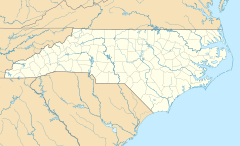Huntsville, North Carolina facts for kids
Quick facts for kids
Huntsville
|
|
|---|---|
| Country | United States |
| State | North Carolina |
| County | Yadkin |
| Elevation | 863 ft (263 m) |
| Time zone | UTC-5 (Eastern (EST)) |
| • Summer (DST) | UTC-4 (EDT) |
| GNIS feature ID | 987275 |
Huntsville is a small community in Yadkin County, North Carolina, United States. It's not an official town, but an "unincorporated community." This means it doesn't have its own local government like a city or town. Huntsville was first officially recognized in 1792. Today, it has a volunteer fire department and a community center with a baseball field. This field is home to the Huntsville little league teams.
Contents
Huntsville's Early History
The Important Shallow Ford
European settlers arrived in the Huntsville area as early as the 1740s. They were attracted by a special place called the Shallow Ford. This was a natural gravel path under the Yadkin River. It was the only spot nearby where heavy wagons could cross the river safely.
The Shallow Ford became part of a major travel route called the Great Wagon Road. In 1753, a road was built from the Moravian settlement of Bethabara to the Shallow Ford. This made the village a popular stop for stagecoaches. Travelers could continue south to cities like Salisbury, Charlotte, and even Georgia. By 1770, the Shallow Ford was also part of the Daniel Boone Trail leading to Kentucky.
The area was first known as the Bryan Settlement. It was named after Morgan Bryan, a Quaker from Pennsylvania. He settled near the Shallow Ford in 1748. An early settler named Edward Hughes may have arrived even earlier, around 1747. He opened a tavern and inn for travelers.
Revolutionary War Events
The Battle of Shallow Ford
On October 14, 1780, an important battle took place near Huntsville. It was called the Battle of Shallow Ford. About 300 Loyalists (people loyal to Britain) fought against 350 Patriots (people fighting for American independence). The Loyalists were trying to hide in the mountains north of the Yadkin River.
The Patriots, led by Major Joseph Cloyd, set up a surprise attack. The Loyalists were spread out in a long line. When they moved down a hill, the Patriots attacked. The fighting was quick and fierce. The Loyalists were defeated and scattered.
Fifteen people were reported to have been hurt or killed in the battle. One Patriot, Captain Henry Francis, died. A tombstone at the battle site honors him. A large tree, known as the Big Poplar Tree, is believed to have been hit during the battle.
Lord Cornwallis Crosses the Yadkin
On January 7, 1781, Lord Charles Cornwallis, a British general, led his army across the Yadkin River at the Shallow Ford. His army had about 2,800 British soldiers. They camped on the east side of the river.
The next morning, Patriot officers watched from a hill. They expected to see the British crossing the river. Instead, they saw the British army marching away towards Bethania, North Carolina. A small group of Patriots followed the British for about five miles. They captured a few British soldiers and their allies.
Huntsville Becomes a Town
In 1792, a man named Charles Hunt bought 250 acres (about 1 square kilometer) of land. He started planning out lots for a new town. A post office opened in Huntsville in 1795. Several stores were also built. One famous store was the Red Store, run by Jacob Clingman. His son, Thomas Lanier Clingman, who became a famous general, was born nearby.
In 1807, a local senator tried to change the town's name to Eatonsville, but it didn't happen. By 1851, Huntsville had 79 lots of land.
Civil War Skirmish
In the last days of the American Civil War, in April 1865, Union troops arrived near the Shallow Ford. They surprised a group of Confederate Home Guard soldiers. The Confederates fought briefly, then ran away. They left behind many new guns.
The Union troops then looted and burned much of Huntsville. This included the Red Store. After that, they continued south towards Mocksville and Salisbury.
Huntsville in Recent Times
In the 1900s, the Shallow Ford became less important. New highways were built that went around the community. This caused Huntsville to slowly decline. In 1920, a bridge was built north of the Shallow Ford, so people no longer needed to use the ford to cross the river.
Today, Huntsville is mostly a rural area. Some historic homes still stand. However, it has been growing recently because it is close to the city of Winston-Salem.
A historic building called the White House was added to the National Register of Historic Places in 1982. This means it is recognized as an important historical site.
Notable People from Huntsville
Huntsville has been home to some interesting people:
- Thomas Lanier Clingman: He was a North Carolina Congressman, a United States Senator, and a General in the Confederate States Army. He was born near Huntsville.
- Richard Irving Dodge: He was an officer in the United States Army and an author.
- Richard Clauselle Puryear: He served as a U.S. congressman from 1853 to 1857.


